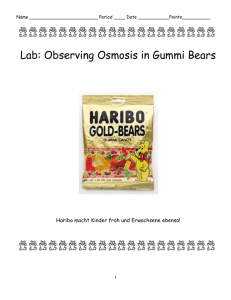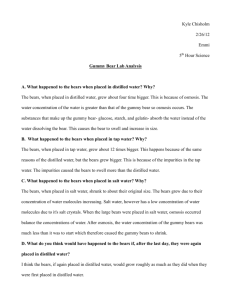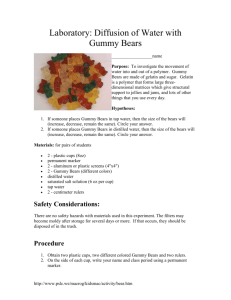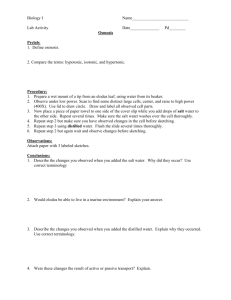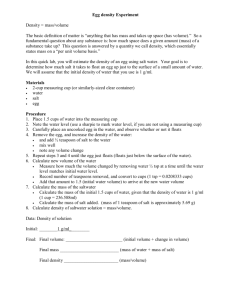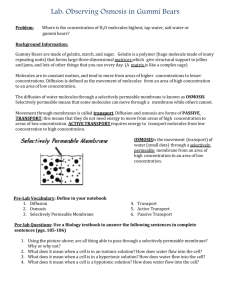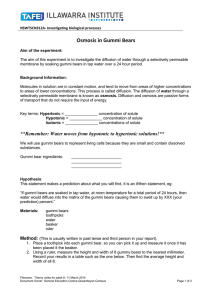Gummibear Osmosis
advertisement
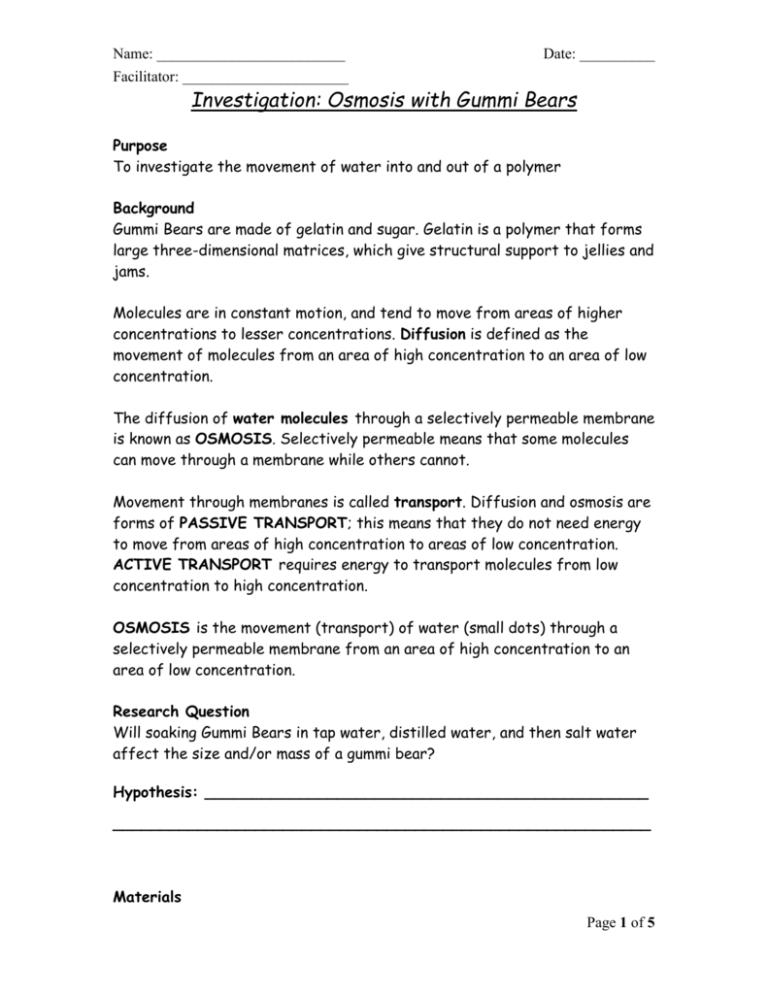
Name: _________________________ Facilitator: ______________________ Date: __________ Investigation: Osmosis with Gummi Bears Purpose To investigate the movement of water into and out of a polymer Background Gummi Bears are made of gelatin and sugar. Gelatin is a polymer that forms large three-dimensional matrices, which give structural support to jellies and jams. Molecules are in constant motion, and tend to move from areas of higher concentrations to lesser concentrations. Diffusion is defined as the movement of molecules from an area of high concentration to an area of low concentration. The diffusion of water molecules through a selectively permeable membrane is known as OSMOSIS. Selectively permeable means that some molecules can move through a membrane while others cannot. Movement through membranes is called transport. Diffusion and osmosis are forms of PASSIVE TRANSPORT; this means that they do not need energy to move from areas of high concentration to areas of low concentration. ACTIVE TRANSPORT requires energy to transport molecules from low concentration to high concentration. OSMOSIS is the movement (transport) of water (small dots) through a selectively permeable membrane from an area of high concentration to an area of low concentration. Research Question Will soaking Gummi Bears in tap water, distilled water, and then salt water affect the size and/or mass of a gummi bear? Hypothesis: _______________________________________________ _________________________________________________________ Materials Page 1 of 5 o o o o o o o o o (2) Gummi Bears (3) clear plastic cups (8oz) Distilled water Tap water Small squares of foil Centimeter ruler Saturated salt solution (water and carton of salt) Paper towels Permanent marker Procedure Day 1 1. Obtain two clear plastic cups and two different color gummi bears. 2. Label one cup tap water and the other distilled water with your marker. 3. Measure your bears from top to bottom (length), from side to side (width) and from front to back (height). Use your measurements to calculate the volume. Record your data in the data table. 4. Place the bears in the cups. 5. Pour distilled water in the cup marked distilled. Pour enough water in the cup to fully cover the bear (1/2 cup full). 6. Pour tap water in the cup marked tap. Pour enough water in the cup to fully cover the bear (1/2 cup full). 7. Set the cups aside and let them soak overnight. 8. Now make your saturated salt solution. To make the saturated salt solution measure out one (1) cup of warm tap water. Add salt to the water one tablespoon at a time, stirring after each addition. Keep Page 2 of 5 count of the number of tablespoons you are adding to the water. You will not need to add the entire carton of salt to the water. When adding the salt to the water, stir after each addition of salt, until all the salt is dissolved. Keep adding salt, one (1) tablespoon at a time, making sure that the salt dissolves completely with each addition until the salt stops dissolving. When this happens salt crystals will be visible at the bottom of your cup. Set your saturated salt solution aside until the next day. Check out this YouTube video for clarification: https://www.youtube.com/watch?v=95ChO2oEJPA How many tablespoons of salt did you add to the water? ____ Day 2 9. On the next lab day, pour all the water from each cup. Then gently place the gummy bear on a small sheet of foil. Use a paper towel to gently blot the water from the foil. 10. How do your gummi bears look? __________________________ __________________________________________________ 11. While on the foil, measure the height, width, and depth. Calculate the volume (length x width x height = volume). Record your data. 12. Place the gummy bears back into their respective cups. Cover the bears with the saturated salt solution you made the day before. Let this sit overnight. 13. Make a new hypothesis. What will happen to the gummi bears in the salt water? ___________________________________________ ____________________________________________________ Day 3 14. On the third lab day find the length, width, and height of the bears using the same procedure as the previous day. Don’t forget to record your data and calculate the volume. Data Table for Volume: Page 3 of 5 Dimensions Gummi Bear 1 (color: _______) Before After tap After Soaking water salt (day 1) (day 2) water (day 3) Gummi Bear 2 (color:________) Before After After soaking distilled salt (day 1) water water (day 2) (day3) Length (cm) Width (cm) Height (cm) Volume (cm3) Conclusion Answer questions 1 through 5 on a separate piece of paper and attach to this sheet. 1. What happened to the bears when placed in distilled water? Why? 2. What happened to the bears when placed in tap water? Why? 3. Was there a difference in your results using tap water compared to distilled water? If so, why? 4. What happened to the bears when placed in salt water? Why? 5. What do you think would have happened to the bears if, after the last day, they were again placed in distilled water? 6. Calculate the percent change in volume after each step of the experiment. a. % change in volume = (final volume - initial volume)/ initial volume x 100 b. Place the percentages in the table below: Bears % Change in Water % Change in Salt Water Tap Water Bear Distilled Water Bear 7. Make a bar graph of the percent changes. a. Label axes b. Place a scale on the vertical axis and give the graph a title. Place the data for both bears on the same graph. USE GRAPH PAPER or Create a Graph. Page 4 of 5 c. If you have a negative value for a percent change, start the vertical axis at a negative number. (For example: -50, -25, 0, 25, 50, 75, 100, etc.) 8. On a separate piece of paper, write a paragraph that explains the results of this experiment using the concept of diffusion. Include your data where appropriate to explain your results. Page 5 of 5


